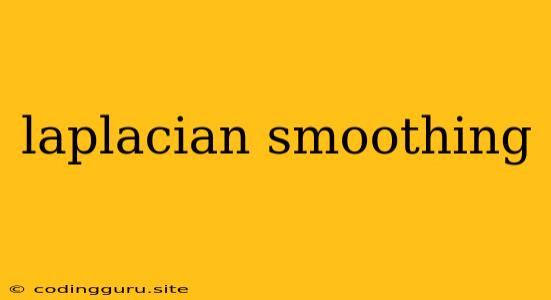Laplacian Smoothing: Understanding the Basics
Laplacian smoothing, a technique used in image processing, is a powerful tool for enhancing image clarity and reducing noise. It utilizes a discrete Laplacian operator to identify areas of abrupt change in image intensity, often representing edges or noise. This method achieves smoothing by replacing pixel values with an average of their neighbors, weighted according to their proximity and the Laplacian response.
What is Laplacian Smoothing?
In essence, Laplacian smoothing aims to reduce the "sharpness" of edges and noise in an image by blurring them. It achieves this by calculating the Laplacian of each pixel, a measure of the local curvature or change in intensity. Pixels with high Laplacian values indicate sharp transitions, while those with low values represent smoother areas.
How Does it Work?
Laplacian smoothing employs a Laplacian kernel, a small matrix that represents the Laplacian operator. This kernel is applied to each pixel in the image, computing the Laplacian response based on the surrounding pixels. The Laplacian response is then used to modify the original pixel value.
For example, consider a simple 3x3 Laplacian kernel:
[ 0 1 0 ]
[ 1 -4 1 ]
[ 0 1 0 ]
This kernel emphasizes changes in the horizontal and vertical directions. When applied to a pixel, it calculates the weighted sum of the neighboring pixels, with the center pixel having a negative weight (-4). Positive weights are assigned to the immediate horizontal and vertical neighbors (1), while the diagonal neighbors have zero weight (0).
The resulting Laplacian response reflects the degree of change in the pixel's neighborhood. A high response indicates a sharp edge or noise, while a low response suggests a smoother area.
Why Use Laplacian Smoothing?
Laplacian smoothing is a valuable technique for various applications in image processing:
- Noise Reduction: It can effectively remove random noise, particularly salt-and-pepper noise, by blurring the noisy pixels.
- Edge Enhancement: By highlighting edges, Laplacian smoothing can improve image clarity and make features more prominent.
- Feature Extraction: It can be used to extract edges and other significant features in an image, enabling further analysis and processing.
Applying Laplacian Smoothing
To apply Laplacian smoothing, you can use various software libraries and tools:
- Python with OpenCV: OpenCV (Open Source Computer Vision Library) provides powerful image processing functions, including Laplacian smoothing.
- MATLAB: MATLAB's image processing toolbox offers efficient tools for implementing Laplacian smoothing algorithms.
- Image Processing Software: Many image editing programs include built-in filters for Laplacian smoothing.
Advantages of Laplacian Smoothing
Laplacian smoothing offers several advantages:
- Simplicity: It's a conceptually simple technique that can be easily implemented.
- Efficiency: It's computationally efficient, making it suitable for real-time applications.
- Flexibility: It can be adapted to different image types and noise levels.
Disadvantages of Laplacian Smoothing
While powerful, Laplacian smoothing has limitations:
- Blurring of Fine Details: It can blur fine details along with noise, potentially affecting image quality.
- Artifacts: Over-application can lead to artifacts, such as halo effects, around edges.
- Sensitivity to Noise: It can be sensitive to high levels of noise, potentially amplifying unwanted artifacts.
Conclusion
Laplacian smoothing is a valuable technique for enhancing image quality by reducing noise and highlighting edges. By understanding its principles and limitations, you can effectively use it for various image processing tasks. Remember to consider the specific image content and noise levels when applying this method to avoid unwanted blurring or artifacts.
